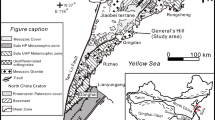Abstract
Coesite-bearing eclogites from Dabieshan (central China) have been studied by ion microprobe to provide information on trace element distributions in meta-basaltic mineral assemblages during high-pressure metamorphism. The primary mineralogy (eclogite facies) appears to have been garnet and omphacite, usually with coesite, phengite and dolomite, together with high-alumina titanite or rutile, or both titanite and rutile; kyanite also occurs occasionally as an apparently primary phase. It is probable that there was some development of quartz, epidote and apatite whilst the rock remained in the eclogite facies. A later amphibolite facies overprint led to partial replacement of some minerals and particularly symplectitic development after omphacite. They vary from very fine-grained dusty-looking to coarser grained Am + Di + Pl symplectites. The eclogite facies minerals show consistent trace element compositions and partition coefficients indicative of mutual equilibrium. Titanite, epidote and apatite all show high concentrations of REE relative to clinopyroxene. The compositions of secondary (amphibolite facies) minerals are clearly controlled by local rather than whole-rock equilibrium, with the composition of amphibole in particular depending on whether it is replacing clinopyroxene or garnet. REE partition coefficients for Cpx/Grt show a dependence on the Ca content of the host phases, with D REE Cpx/Grt decreasing with decreasing D Ca . This behaviour is very similar to that seen in mantle eclogites, despite differences in estimated temperatures of formation of 650–850 °C (Dabieshan) and 1000–1200 °C (mantle eclogites). With the exception of HREE in garnet, trace elements in the eclogites are strongly distributed in favour of minor or accessory phases. In particular, titanite and rutile strongly concentrate Nb and Zr, whilst LREE–MREE go largely into epidote, titanite and apatite. If these minor/accessory minerals behave in a refractory manner during melting or fluid mobilisation events and do not contribute to the melt/fluid, then the resultant melts and fluids will be strongly depleted in LREE–MREE.
Similar content being viewed by others
Author information
Authors and Affiliations
Additional information
Received: 11 February 1999 / Accepted: 31 January 2000
Rights and permissions
About this article
Cite this article
Sassi, R., Harte, B., Carswell, D. et al. Trace element distribution in Central Dabie eclogites. Contrib Mineral Petrol 139, 298–315 (2000). https://doi.org/10.1007/s004100000133
Published:
Issue Date:
DOI: https://doi.org/10.1007/s004100000133




